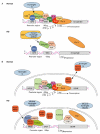Huntingtin and the molecular pathogenesis of Huntington's disease. Fourth in molecular medicine review series
- PMID: 15459747
- PMCID: PMC1299150
- DOI: 10.1038/sj.embor.7400250
Huntingtin and the molecular pathogenesis of Huntington's disease. Fourth in molecular medicine review series
Abstract
Huntington's disease (HD) is a late-onset neurodegenerative disorder that is caused by a CAG repeat expansion in the IT15 gene, which results in a long stretch of polyglutamine close to the amino-terminus of the HD protein huntingtin (htt). The normal function of htt, and the molecular mechanisms that contribute to the disease pathogenesis, are in the process of being elucidated. In this review, we outline the potential functions of htt as defined by the proteins with which it has been found to interact. We then focus on evidence that supports a role for transcriptional dysfunction and impaired protein folding and degradation as early events in disease pathogenesis.
Figures



Similar articles
-
Huntington's Disease.Cold Spring Harb Perspect Biol. 2011 Jun 1;3(6):a007476. doi: 10.1101/cshperspect.a007476. Cold Spring Harb Perspect Biol. 2011. PMID: 21441583 Free PMC article. Review.
-
Huntington's Disease: Mechanisms of Pathogenesis and Therapeutic Strategies.Cold Spring Harb Perspect Med. 2017 Jul 5;7(7):a024240. doi: 10.1101/cshperspect.a024240. Cold Spring Harb Perspect Med. 2017. PMID: 27940602 Free PMC article. Review.
-
PRMT5- mediated symmetric arginine dimethylation is attenuated by mutant huntingtin and is impaired in Huntington's disease (HD).Cell Cycle. 2015;14(11):1716-29. doi: 10.1080/15384101.2015.1033595. Cell Cycle. 2015. PMID: 25927346 Free PMC article.
-
Lessons from animal models of Huntington's disease.Trends Genet. 2002 Apr;18(4):202-9. doi: 10.1016/s0168-9525(01)02625-7. Trends Genet. 2002. PMID: 11932021 Review.
-
Huntington's disease: translating a CAG repeat into a pathogenic mechanism.Curr Opin Neurobiol. 1996 Oct;6(5):638-43. doi: 10.1016/s0959-4388(96)80097-3. Curr Opin Neurobiol. 1996. PMID: 8937828 Review.
Cited by
-
Aggregation of polyQ proteins is increased upon yeast aging and affected by Sir2 and Hsf1: novel quantitative biochemical and microscopic assays.PLoS One. 2012;7(9):e44785. doi: 10.1371/journal.pone.0044785. Epub 2012 Sep 6. PLoS One. 2012. PMID: 22970306 Free PMC article.
-
Attenuation of Rhes activity significantly delays the appearance of behavioral symptoms in a mouse model of Huntington's disease.PLoS One. 2013;8(1):e53606. doi: 10.1371/journal.pone.0053606. Epub 2013 Jan 21. PLoS One. 2013. PMID: 23349722 Free PMC article.
-
Potential for therapeutic manipulation of the UPR in disease.Semin Immunopathol. 2013 May;35(3):351-73. doi: 10.1007/s00281-013-0370-z. Epub 2013 Apr 10. Semin Immunopathol. 2013. PMID: 23572207 Free PMC article. Review.
-
ESC-Derived BDNF-Overexpressing Neural Progenitors Differentially Promote Recovery in Huntington's Disease Models by Enhanced Striatal Differentiation.Stem Cell Reports. 2016 Oct 11;7(4):693-706. doi: 10.1016/j.stemcr.2016.08.018. Epub 2016 Sep 29. Stem Cell Reports. 2016. PMID: 27693427 Free PMC article.
-
Sertraline slows disease progression and increases neurogenesis in N171-82Q mouse model of Huntington's disease.Neurobiol Dis. 2008 Jun;30(3):312-322. doi: 10.1016/j.nbd.2008.01.015. Epub 2008 Mar 10. Neurobiol Dis. 2008. PMID: 18403212 Free PMC article.
References
-
- Bates G (2003) Huntingtin aggregation and toxicity in Huntington's disease. Lancet 361: 1642–1644 - PubMed
-
- Bates GP, Murphy KP (2002) in Huntington's Disease (eds Bates GP, Harper PS, Jones AL) 387–426. Oxford, UK: Oxford University Press
-
- Bates GP, Harper PS, Jones AL (eds) (2002) Huntington's Disease. Oxford, UK: Oxford University Press.
-
- Bence NF, Sampat RM, Kopito RR (2001) Impairment of the ubiquitin–proteasome system by protein aggregation. Science 292: 1552–1555 - PubMed
Publication types
MeSH terms
Substances
LinkOut - more resources
Full Text Sources
Other Literature Sources
Medical

